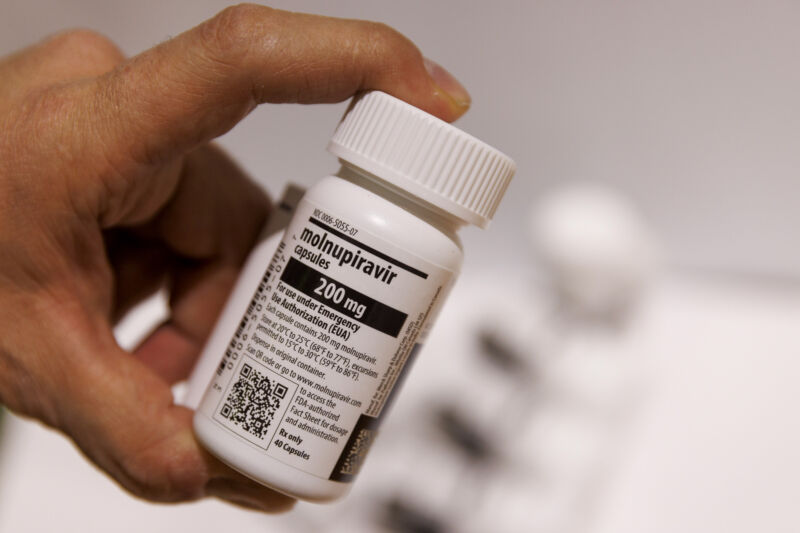

With every new infection, the pandemic coronavirus gets new chances to mutate and adapt, creating opportunities for the virus to evolve new variants that are better at dodging our immune systems and making us sicker.
Anti-viral drugs, such as Paxlovid and remdesivir, aim to halt this incessant evolution in individual patients—shortening illnesses, snuffing out opportunities for mutation, and reducing transmission. But one antiviral appears to be backfiring—allowing SARS-CoV-2 more opportunities to mutate.
According to a new peer-reviewed study in the journal Nature, the anti-viral drug dubbed molnupiravir is linked to specific SARS-CoV-2 mutation signatures that happened to spring up in 2022 when the drug was introduced.
The study’s authors—led by researchers at the Francis Crick Institute in London and the University of Cambridge—scanned through more than 15 million SARS-CoV-2 genome sequences found in global databases. They picked out unique mutation signatures that closely linked to signatures seen in viruses from patients known to have been treated with molnupiravir. These suspected molnupiravir-linked mutation signatures also matched those seen in viruses examined in a clinical trial of molnupiravir. Overall, the signatures appeared in older people, who are most likely to have been treated with an antiviral, and people in countries where molnupiravir has often been used.
Beyond simply finding molnupiravir-linked mutations, the researchers noted concerning features of them. The researchers found evidence that some of the molnupiravir-linked mutations were under positive selection—that is, they increased in frequency, suggesting that they were advantageous to the virus in some way. They also noted that some viruses with molnupiravir-linked mutations were passed on from person to person in clusters, which suggested onward transmission of these drug-induced mutations.
The findings indicate that “molnupiravir results in new mutations, increasing the genetic diversity in the surviving viral population,” Theo Sanderson, lead author and postdoctoral researcher at the Francis Crick Institute, said in a statement.
For now, there is no evidence that molnupiravir has contributed to the development of any of the most significant SARS-CoV-2 variants, such as omicron. And the clusters of transmission seen in the data are small. Still, Sanderson says the study’s finding is important for weighing the risks and benefits of molnupiravir, highlighting the “possibility of persistent antiviral-induced mutations.”
Code switching
Molnupiravir seems to induce these mutation signatures in a unique way compared with some other antivirals. The small-molecule drug is a nucleoside analog—that is, it poses as a building block of RNA, specifically of cytosine (represented by C in RNA and DNA coding of G, A, C, and U/T, respectively).
During an infection, SARS-CoV-2—a virus with a positive-sense, single-stranded RNA genome—has to make copies of its genome in human cells to package into new viruses that infect more cells. It replicates using a specialized enzyme called an RNA-dependent RNA polymerase. In the presence of molnupiravir, the polymerase will sometimes plop in an active form of molnupiravir into the new copy of an RNA strand instead of cytosine—switching a C to an M. The idea is that with enough Ms in place of Cs, the new RNA molecule will be so riddled with errors that its creation will lead to “error catastrophe.” Basically, this is a concept in which the genetic error rate exceeds a threshold for virus survival.
But, apparently, the inclusion of some Ms in the code isn’t always catastrophic, and the virus keeps on replicating. Then, things get worse. Once incorporated into an RNA strand, the M can transition (tautomerizes) into an alternative form that resembles another RNA building block—uracil or U.
So, if you’ll recall, between normal RNA strand, a C pairs opposite of a guanine, G, and U pairs opposite with adenine, A. But, with a non-catastrophic molnupiravir around, G’s first pair with M’s, which that can then pose as U’s and pair with A’s in the next replication cycle. The outcome is a mutation that replaces a G with an A in the code. And with more rounds of replication, C’s can switch to U’s (or T’s in DNA coding). There is other letter-switching mayhem that can arise, but unusually high frequencies of G-to-A and C-to-U switches were common mutational signatures linked to molnupiravir.
Heavy risks
Molnupiravir is unique in this way. Though remdesivir is also a nucleoside analog, it is thought to cause “chain termination,” which is when it stops a new strand of RNA from growing. Paxlovid, meanwhile, works to stop the virus by targeting an enzyme necessary for replication.
When molnupiravir was authorized in the US, there was concern about its potential to cause mutations in people’s DNA, rather than the virus. For this reason, it is not recommended for use in pregnant people. But the new data gives birth to more concern about mutations. And this risk is coupled with lackluster efficacy data. In a final data analysis for the Food and Drug Administration, molnupiravir’s maker, Merck, combined two sets of trial data to come up with an estimate of just 30 percent efficacy at preventing hospitalization and death.
FDA advisors summarized the data at the time as “not overwhelmingly good” and “modest at best.” They voted in favor of authorizing the drug in a narrow 13 to 10 vote. The drug has never gained a foothold in Europe. Earlier this year, the European Medicines Agency refused to issue marketing authorization for molnupiravir. Upon the EMA’s rejection, Merck said it was confident of the drug’s role in fighting COVID-19 and that it would appeal the decision. In addition to the US, molnupraivir is approved for use in over two dozen countries, including Australia, China, Japan, and the UK, though use of the drug has been scaled back in many places.
Overall, the authors of the new study say the findings should factor into decisions on any continued use of molnupiravir and beyond. “These data will be useful for ongoing assessments of the risks and benefits of this treatment, and may guide the future development of mutagenic agents as antivirals, particularly for viruses with high mutational tolerances such as coronaviruses,” they conclude.

